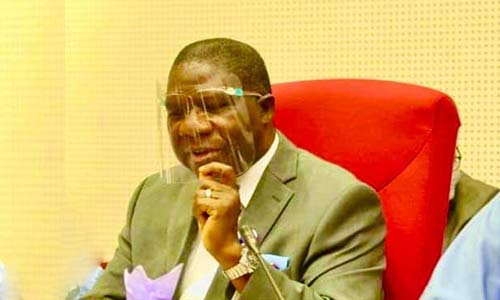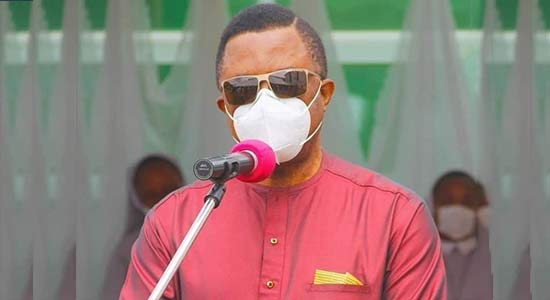NEWS UPDATES 17/06/2022
Adamawa Confirms 5 Cases, Additional 57 Suspected Cases Of Monkeypox

The Adamawa State director of Public Health, Dr. Celine Laori, said, there has been an outbreak of monkeypox in Adamawa state.
Dr. Laori said, there have been as at 12th June, 2022, five laboratory confirmed cases of monkeypox in Adamawa state and another 57 suspected cases of the disease in Adamawa.
This was made known by the Adamawa state Director of Public Health, Dr. Celine Laori, in an exclusive chat with Daily Sun in Yola, Adamawa state.
Dr. Celine said, the monkeypox was first notice sometimes between late April and early May at Army barracks and later on at the Yola correctional facility. She explained that, so far the disease has been noticed in two local governments of Yola north and Yola South.
According to Celine Laori, “Yes there has been an outbreak of Monkeypox in the state which was registered in late April by the Honourable Commissioner of Health, almost at the time when he was declaring the end of cholera response.
“There was a case that was picked up in the army barracks then. if you pick up one case, it is enough to declare an outbreak.
“Subsequently there was also an outbreak at the correctional facility in Jimeta. Few other cases were picked up from other place.
“But so far, there have been fifty seven (57) suspected cases reported at present and we have about five (5) laboratory confirmed cases as at 12th June 2022 and the cases affect two local governments which are Yola north and Yola South but no mortality has been recorded yet.”
Speaking on the medical response on the outbreak, Dr. Laori said, “The state government have already set up an Emergency Operational Center, which is much more like a control center to curb the spread of the virus.
“The disease is caused by a virus which is similar to small pox virus. We immediately swung into action and an active case search was initiated, workers were trained to be able to identify monkeypox which is relatively new to our community.
“This is the first time we are having the case in the state, so workers were trained by our partner which is WHO, and they are back in our communities trying to actively search for new cases.
“We also went back to the correctional center where the inmates were sensitized and the place fumigated and anybody that needed case management was also treated, so we are still doing follow-ups for the cases but most of them have been resolved.”
Advising the public on how to recognise and handle any possible case of monkeypox, she said, “The public are cautioned to take notes of the symptoms and report themselves to the nearest medical facility. Once any symptoms is noticed such as a low grade fever, some form of pyrexia, in most cases one has rashes all over the face and the body which resembles the rash of a chicken pox, but this one typically presents with pores inside the rashes, so that is how we differentiate between Chicken pox from Monkeypox, but anyone that has the rash should rush to the closest health facility where that distinction can be made.
“It cannot be made by the person involved, so they have to come to the facility for samples to be taken and sent to Abuja for test, that is the only way we can confirm if it is Monkeypox or something else.
“Monkeypox is also a contagious disease, so anyone that contracts it should be isolated and be managed. If it is at home, the person should be Isolated. usually it is mild, it does not require hospitalization except for the serious cases but if is very serious we can hospitalized and isolate then while in the hospital.
“Hygiene should also be observed. You have to keep the environment clean, let them bath with soap and water in that way they could prevent other people from contracting the disease.
“The diseases is not life threatening even though there are variants that can also lead to mortality but the one we have around here is not.
“Although, our neighbouring country, Cameroon, has the life threatening variant, so because of the movements across the border, the possibility of the deadly variant to be here in Adamawa is real.
“That is why we are very alert and we are building capacity and preparation to handle any possibility.
“We are, however, challenged with the issue of knowledge gap in the environment as to what monkeypox is and its effects. So there is an urgent need for education and information dissemination.
“The press need to help us announce that this disease is around and the symptoms and how it can be managed, that way if people are aware because we think there are many more cases within our communities but people do not know what it is so there is a need for sensitisation.
“We are also soliciting for the support of partners, if our partners can come in to support us, we can go out and actively search for this cases in our communities. ”
Earlier since 13 May 2022, and as of 2 June 2022, 780 laboratory confirmed cases of monkeypox have been reported to or identified by WHO from 27 Member States across four WHO regions that are not endemic for monkeypox virus.
Epidemiological investigations are ongoing. Most reported cases so far have been presented through sexual health or other health services in primary or secondary health care facilities and have involved mainly, but not exclusively, men who have sex with men (MSM).
While the West African clade of the virus has been identified from samples of cases so far, most confirmed cases with travel history reported travel to countries in Europe and North America, rather than West or Central Africa where the monkeypox virus is endemic.
The confirmation of monkeypox in persons who have not travelled to an endemic area is atypical, and even one case of monkeypox in a non-endemic country is considered an outbreak. While most cases are not associated with travel from endemic areas, Member States are also reporting small numbers of cases in travelers from Nigeria, as has been observed before.
The sudden and unexpected appearance of monkeypox simultaneously in several non-endemic countries suggests that there might have been undetected transmission for some unknown duration of time followed by recent amplifier events.
WHO assesses the risk at the global level as moderate considering this is the first time that many monkeypox cases and clusters are reported concurrently in non-endemic and endemic countries in widely disparate WHO geographical areas.
WHO continues to receive updates on the situation in endemic countries.
As of 2 June 2022, 780 laboratory confirmed cases have been notified to WHO under the International Health Regulations (IHR) or identified by WHO from official public sources in 27 non-endemic countries in four WHO Regions.
This represents an increase of 523 laboratory confirmed cases (+203%) since the Disease Outbreak News of 29 May, when a total of 257 cases were reported. As of 2 June 2022, there have been no deaths associated within the current monkeypox outbreak in non-endemic countries, however, cases and deaths continue to be reported from endemic countries.
While investigations are ongoing, preliminary data from polymerase chain reaction (PCR) assays indicate that the monkeypox virus strains detected in Europe and other non-endemic areas belong to the West African clade.
The geographical distribution of monkeypox cases reported to or identified by WHO between 13 May to 2 June 2022 in non-endemic countries.
The majority of cases (n=688; 88%), were reported from the WHO European Region (20 Countries). Confirmed cases have also been reported from the Region of the Americas (n=80; 10%), Eastern Mediterranean Region (n=9; 1%) and Western Pacific Region (n=3; <1%). The case count fluctuates as more information becomes available daily and data is verified by WHO in accordance with the provisions of the IHR.



